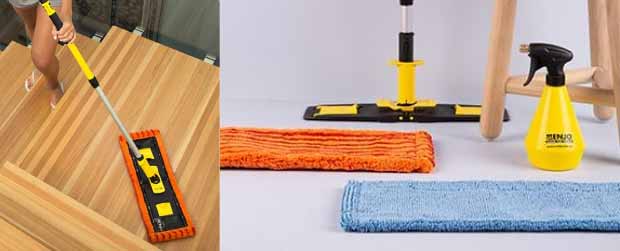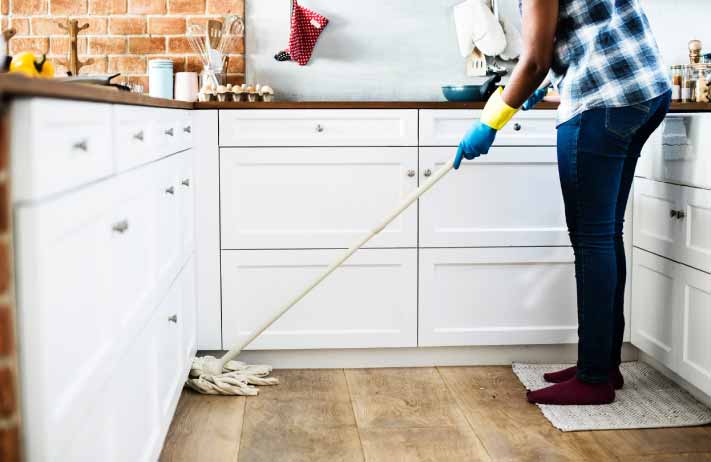Many consumers are mis-guided towards tiles or vinyl, being told that cleaning timber floors and maintaining their natural shine is an unforgiving daily chore.
Truth is, hardwood timber floors are not just a durable and beautiful addition to your home, for those responsible for doing the cleaning timber flooring is going to make your life a lot easier.
But please be very cautious before you start throwing all kinds of cleaning products on your timber floor!
There are many important factors you need to be aware of that will determine how easy it is to clean your timber floor and prevent your cleaning solutions from having adverse effects on the timber.
Let’s look at the best process for cleaning and I will also point out the important issues you need to be aware of to avoid damaging your floor.
Sweeping and Dusting a Timber Floor
The first step is to get rid of all the dirt and dust which has built up on the surface of your floor. The best way to do this is with a soft bristle broom, or a vacuum cleaner. If using a vacuum cleaner, we highly recommend you use an attachment with a soft floor brush head.
Before you start going over the floor with any vacuum cleaner, feel around the nozzle to make sure there aren’t any harsh edges. Some older style vacuum’s have sharp heavy heads which are not ideal for cleaning timber floors and could possibly scratch the surface.
Depending on how many people you live with and whether you have pets, you will probably only have to sweep or vacuum once a week.
Removing Dirt and Grime From Your Timber Floor
The next step in the process is to clean of the sticky surface layer of grime.
It doesn’t matter if your floor is engineered timber, solid timber, or Stabilised Solid, the process to cleaning the surface will be the same. If the floor isn’t in such a bad state, all you need to do is put some warm (not hot) water in a bucket and give a light going over with the damp (not wet) mop.
Don’t soak your floor! Remember to use a damp mop not a wet mop.
A more convenient solution, which is how we clean all our floors laid here in our Osborne Park showroom, is using an Enjo microfibre mop with a spray water bottle. As, we have quite a lot of foot traffic in our showroom we find this method to be the most convenient as there is literally zero setup time for the micro-fiber mop and bottle is always ready to go.
Do not steam clean your timber floor! As timber is a natural product, using a steam cleaning method will cause the floorboards to expand then retract, which can cause the cracking of the boards.

Should I Use Timber Floor Cleaning Products?
If the warm water isn’t quite getting through the sticky surface layer of dirt you will need to take it up a notch and use a stronger cleaning solution.
If you have a pre-finished boards, meaning is has been acclimatized and coated in a factory, you can use all kinds of cleaning products, alcohol or chemical based. If your floor isn’t pre-finished, which is more common with solid timber flooring, you shouldn’t use a chemical based cleaning solution. Many of these products can react to the varnish and leave a cloudy look on the surface layer of your floor.
Look at your local DIY store or supermarket and you’ll find a range of different solutions for cleaning timber floors. We strongly suggest you do a test on a small area first just to make sure that there is nothing in the cleaner that reacts to the coating of your floor.
Here at Lifewood we stock a range of WOCA cleaning products suitable for all kinds of timber floors.
A word of warning. Be cautious of other homemade cleaning methods you may find online. Always test on a small subtle area first and wait a couple of days before deciding that it’s okay for your floor.
A common homemade solution you will see is mixing vinegar with water. This solution is harmless for timber floors which have a polyurethane coating, but don’t use this if your floor has an oil finish because it will dry out your floor.
Common issue with cheap timber floors
One big issue with you need to consider before buying a timber floor is what types of timber is being used throughout the whole board. If you are choosing a cheaper engineered board, chances are only the top layer will be solid timber (20%) and the lower layers will be a cheaper wood like pine or ply.
These cheap woods will drastically change the durability of your floor as they absorb water much easier, causing your floor to crack and weaken as it expands and retracts over time. These boards will often only have a polyurethane coating on the surface layer leaving the under layers uncoated and exposed to moisture.



